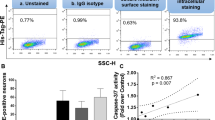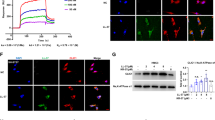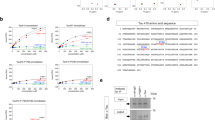Abstract
The mechanisms of neurodegeneration that result in human immunodeficiency virus (HIV) type 1 dementia have not yet been identified. Here, we report that HIV-infected macrophages secrete the zymogen matrix metalloproteinase-2 (MMP-2), which is activated by exposure to MT1-MMP on neurons. Stromal cell–derived factor 1α (SDF-1), a chemokine overexpressed by astrocytes during HIV infection, was converted to a highly neurotoxic protein after precise proteolytic processing by active MMP-2, which removed the N-terminal tetrapeptide. Implantation of cleaved SDF-1(5–67) into the basal ganglia of mice resulted in neuronal death and inflammation with ensuing neurobehavioral deficits that were abrogated by neutralizing antibodies to SDF-1 and an MMP inhibitor drug. Hence, this study identifies a new in vivo neurotoxic pathway in which cleavage of a chemokine by an induced metalloproteinase results in neuronal apoptosis that leads to neurodegeneration.
This is a preview of subscription content, access via your institution
Access options
Subscribe to this journal
Receive 12 print issues and online access
$209.00 per year
only $17.42 per issue
Buy this article
- Purchase on Springer Link
- Instant access to full article PDF
Prices may be subject to local taxes which are calculated during checkout




Similar content being viewed by others
References
Power, C. Retroviral diseases of the nervous system: pathogenic host response or viral gene-mediated neurovirulence? Trends Neurosci. 24, 162–169 (2001).
Rossi, D. & Zlotnik, A. The biology of chemokines and their receptors. Annu. Rev. Immunol. 18, 217–242 (2000).
Ransohoff, R.M. & Tani, M. Do chemokines mediate leukocyte recruitment in post-traumatic CNS inflammation? Trends Neurosci. 21, 154–159 (1998).
Oberlin, E. et al. The CXC chemokine SDF-1 is the ligand for LESTR/fusin and prevents infection by T-cell-line-adapted HIV-1. Nature 382, 833–835 (1996).
Bleul, C.C. et al. The lymphocyte chemoattractant SDF-1 is a ligand for LESTR/fusin and blocks HIV-1 entry. Nature 382, 829–833 (1996).
Nagasawa, T., Tachibana, K. & Kawabata, K. A CXC chemokine SDF-1/PBSF: a ligand for a HIV coreceptor, CXCR4. Adv. Immunol. 71, 211–228 (1999).
Ohtani, Y. et al. Expression of stromal cell-derived factor-1 and CXCR4 chemokine receptor mRNAs in cultured rat glial and neuronal cells. Neurosci. Lett. 249, 163–166 (1998).
Asensio, V.C. & Campbell, I.L. Chemokines in the CNS: plurifunctional mediators in diverse states. Trends Neurosci. 22, 504–512 (1999).
Miller, R.J. & Meucci, O. AIDS and the brain: is there a chemokine connection. Trends Neurosci. 22, 471–479 (1999).
Epstein, L.G. & Gendelman, H.E. Human immunodeficiency virus type 1 infection of the nervous system: pathogenetic mechanisms [see comments]. Ann. Neurol. 33, 429–436 (1993).
Gonzalez-Scarano, F. & Baltuch, G. Microglia as mediators of inflammatory and degenerative diseases. Annu. Rev. Neurosci. 22, 219–240 (1999).
Kaul, M., Garden, G.A. & Lipton, S.A. Pathways to neuronal injury and apoptosis in HIV-associated dementia. Nature 410, 988–994 (2001).
Sisodia, S.S. Alzheimer's disease: perspectives for the new millennium. J. Clin. Invest. 104, 1169–1170 (1999).
Hook, Y.H. & Mende-Mueller, L. Proteolysis in neurodegenerative diseases. in Molecular Mechanisms of Neurodegenerative Diseases (ed. Chesselet, M.) 111–129 (Humana, Totowa, New Jersey, 2000).
Conant, K. et al. Cerebrospinal fluid levels of MMP-2, 7, and 9 are elevated in association with human immunodeficiency virus dementia. Ann. Neurol. 46, 391–398 (1999).
Johnston, J.B. et al. Lentiviral infection in the brain induce matrix metalloproteinase expression: the role of envelope diversity. J. Virol. 74, 7211–7220 (2000).
Yong, V.W., Power, C., Forsyth, P. & Edwards, D. Metalloproteinases in the biology and pathology of the nervous system. Nat. Rev. Neurosci. 2, 502–511 (2001).
Anthony, D.C. et al. Matrix metalloproteinase expression in an experimentally-induced DTH model of multiple sclerosis in the rat CNS. J. Neuroimmunol. 87, 62–72 (1998).
McCawley, L.J. & Matrisian, L.M. Matrix metalloproteinases: they're not just for matrix anymore! Curr. Opin. Cell Biol. 13, 534–540 (2001).
Lopez-Otin, C. & Overall, C.M. Protease degradomics: a new challenge for proteomics. Nat. Rev. Mol. Cell. Biol. 3, 509–519 (2002).
McQuibban, G.A. et al. Inflammation dampened by gelatinase A cleavage of monocyte chemoattractant protein-3. Science 289, 1202–1206 (2000).
Opdenakker, G. et al. Gelatinase B functions as regulator and effector in leukocyte biology. J. Leukoc. Biol. 69, 851–859 (2001).
McQuibban, G.A. et al. Matrix metalloproteinase cleavage of the chemokine stromal cell derived factor-1 results in loss of chemokine activity. J. Biol. Chem. 276, 43503–43508 (2001).
Lipton, S.A. & Gendelman, H.E. Seminars in medicine of the Beth Israel Hospital, Boston. Dementia associated with the acquired immunodeficiency syndrome. N. Engl. J. Med. 332, 934–940 (1995).
Zhang, K. et al. Human immunodeficiency virus type 1 Clade A and neurotropism: molecular evolution, recombination and co-receptor utilization. Virology 283, 19–30 (2001).
Power, C. et al. Neuronal death induced by brain-derived human immunodeficiency virus type 1 envelope genes differs between demented and nondemented AIDS patients. J. Virol. 72, 9045–9053 (1998).
Overall, C.M. & Lopez-Otin, C. Strategies for MMP inhibition in cancer: innovations for the post-trial era. Nat. Rev. Cancer 2, 657–672 (2002).
Bigg, H.F. et al. Tissue inhibitor of metalloproteinases-4 inhibits but does not support the activation of gelatinase A via efficient inhibition of membrane type 1-matrix metalloproteinase. Cancer Res. 61, 3610–3618 (2001).
Horuk, R. Chemokines beyond inflammation. Nature 393, 524–525 (1998).
Catani, M.V. et al. gp120 induces cell death in human neuroblastoma cells through the CXCR4 and CCR5 chemokine receptors. J. Neurochem. 74, 2373–2379 (2000).
Gong, J.H. & Clark-Lewis, I. Antagonists of monocyte hemoattractant protein 1 identified by modification of functionally critical NH2-terminal residues. J. Exp. Med. 181, 631–640 (1995).
Ungerstedt, U. & Arbuthnott, G.W. Quantitative recording of rotational behaviour in rats after 6-hydroxy-dopamine lesions of nigrostriatal dopamine system. Brain Res. 24, 485–493 (1970).
Glass, J.D., Fedor, H., Wesselingh, S.L. & McArthur, J.C. Immunocytochemical quantitation of human immunodeficiency virus in the brain: correlations with dementia. Ann. Neurol. 38, 755–762 (1995).
Patrick, M.K., Johnston, J.B. & Power, C. Lentiviral neuropathogenesis: comparative neuroinvasion, neurotropism, neurovirulence and host neurosusceptibility. J. Virol. 76, 7923–7931 (2002).
Johnston, J.B., Silva, C. & Power, C. Envelope gene-mediated neurovirulence in feline immunodeficiency virus infection: induction of matrix metalloproteinases and neuronal injury. J. Virol. 76, 2622–2633 (2002).
Berman, N.E. et al. Microglial activation and neurological symptoms in the SIV model of NeuroAIDS: association of MHC-II and MMP-9 expression with behavioral deficits and evoked potential changes. Neurobiol. Dis. 6, 486–498 (1999).
Sanders, V.J. et al. Chemokines and receptors in HIV encephalitis. Aids 12, 1021–1026 (1998).
Kaul, M. & Lipton, S.A. Chemokines and activated macrophages in HIV gp120-induced neuronal apoptosis. Proc. Natl. Acad. Sci. USA 96, 8212–8216 (1999).
Shrikant, P., Benos, D.J., Tang, L.P. & Benveniste, E.N. HIV glycoprotein 120 enhances intercellular adhesion molecule-1 gene expression in glial cells. Involvement of Janus kinase/signal transducer and activator of transcription and protein kinase C signaling pathways. J. Immunol. 156, 1307–1314 (1996).
Nath, A. Pathobiology of human immunodeficiency virus dementia. Semin. Neurol. 19, 113–127 (1999).
Johnston, J.B. et al. HIV-1 Tat neurotoxicity is prevented by matrix metalloproteinase inhibitors. Ann. Neurol. 49, 230–241 (2001).
Langford, D., Sanders, V.J., Mallory, M., Kaul, M. & Masliah, E. Expression of stromal cell-derived factor 1alpha protein in HIV encephalitis. J. Neuroimmunol. 127, 115–126 (2002).
Coussens, L.M., Fingleton, B. & Matrisian, L.M. Matrix metalloproteinase inhibitors and cancer: trials and tribulations. Science 295, 2387–2392 (2002).
Chesebro, B. et al. Identification of human immunodeficiency virus envelope gene sequences influencing viral entry into CD4-positive HeLa cells, T-leukemia cells and macrophages. J. Virol. 65, 5782–5789 (1991).
Mayne, M. et al. Antisense oligodeoxynucleoide inhibition of tumor necrosis factor is neuroprotective following intracerebral hemorrhage. Stroke 32, 240–248 (2001).
Power, C. et al. Intracerebral hemorrhage induces macrophage activation and matrix metalloproteinases. Ann. Neurol. 53, 731–742 (2003).
Imai, Y., Ibata, I., Ito, D., Ohsawa, K. & Kohsaka, S. A novel gene iba1 in the major histocompatibility complex class III region encoding an EF hand protein expressed in a monocytic lineage. Biochem. Biophys. Res. Commun. 224, 855–862 (1996).
Acknowledgements
This work is dedicated to the memory of I. Clark-Lewis (1955–2002). We thank J. Ethier, S. Henry and A. Hood for technical assistance and V.W. Yong and S. Robbins for helpful discussions. K.Z. is a Henri Toupin Medical Foundation Fellow. G.A.M. was supported by a National Cancer Institute of Canada studentship and J.B.J. was supported by an Alberta Heritage Foundation for Medical Research (AHFMR) studentship. I.C.L. was a Canadian Institutes of Health Research (CIHR) Investigator. C.M.O. holds a Canada Research Chair in Metalloproteinase Biology. C.P. is an AHFMR Scholar/CIHR Investigator. These studies were supported by the CIHR, Canadian Arthritis Network of Centers of Excellence, and Canadian Foundation for AIDS Research.
Author information
Authors and Affiliations
Corresponding authors
Ethics declarations
Competing interests
The authors declare no competing financial interests.
Rights and permissions
About this article
Cite this article
Zhang, K., McQuibban, G., Silva, C. et al. HIV-induced metalloproteinase processing of the chemokine stromal cell derived factor-1 causes neurodegeneration. Nat Neurosci 6, 1064–1071 (2003). https://doi.org/10.1038/nn1127
Received:
Accepted:
Published:
Issue Date:
DOI: https://doi.org/10.1038/nn1127
This article is cited by
-
Co-receptor signaling in the pathogenesis of neuroHIV
Retrovirology (2021)
-
Mechanisms of neuronal dysfunction in HIV-associated neurocognitive disorders
Cellular and Molecular Life Sciences (2021)
-
MMPs and ADAMs in neurological infectious diseases and multiple sclerosis
Cellular and Molecular Life Sciences (2019)
-
Matrix metalloproteinases in the CNS: interferons get nervous
Cellular and Molecular Life Sciences (2019)
-
C-terminal truncation of IFN-γ inhibits proinflammatory macrophage responses and is deficient in autoimmune disease
Nature Communications (2018)



